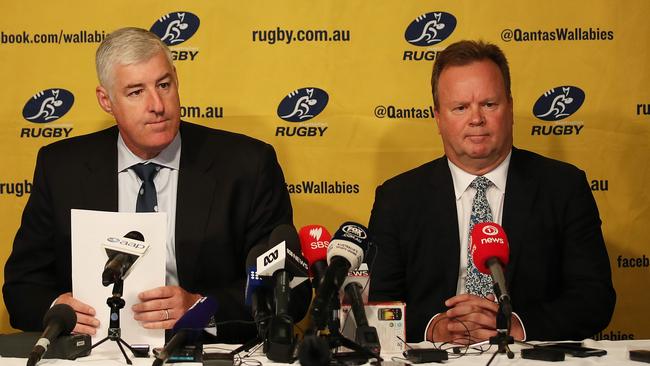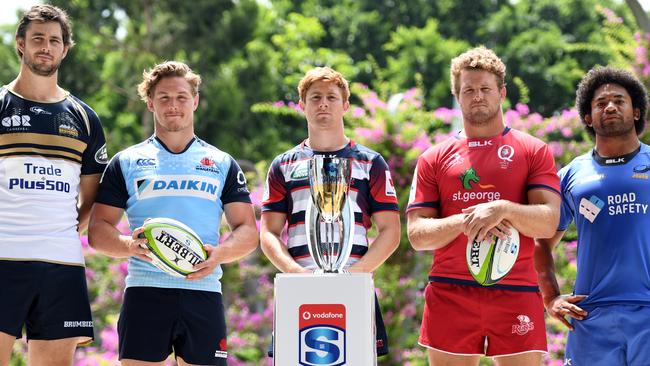ARU says cutting an Australian team from Super Rugby has been on cards since 2011
SIGNING up to the 18-team Super Rugby competition was a “mistake” but the ARU say cutting an Australian franchise had been on the cards since soon after the Melbourne Rebels were born in 2011.
Rugby
Don't miss out on the headlines from Rugby. Followed categories will be added to My News.
SIGNING up to the 18-team Super Rugby competition was a “mistake” but the ARU say cutting an Australian franchise had been on the cards since soon after the Melbourne Rebels were born in 2011.
The ARU said consistent financial pressures had left them no choice but to shut down a team as part of a new Super 15 competition in 2018, which was finally confirmed by SANZAAR on Sunday.
ARU chairman Cameron Clyne said a decision will be made in the next 48-72 hours as to whether the Western Force or the Melbourne Rebels will be axed.
The third club who had been under review, the Brumbies, has been let off the hook and are safe.
PULVER : ‘I’ll quit if they wante me to’
SUPER RUGBY: Calling Kiwi’s bluff would’ve been ‘catastrophic’
ANALYSIS: What Super cull means for Australian rugby
“We have done a lot of work obviously but we want to make sure there is due process and we make sure we make the right decision based on the data being validated. We don’t anticipate this dragging on,” Clyne said.
Clyne said the criteria they’d make a judgment on would be “based on the future attractiveness of that market, the sponsors, fan engagement, high performance outcomes, views from a while range of stakeholders”.
Force fans have rallied passionately behind their team but CEO Bill Pulver spelt out financial considerations were the ARU’s main focus, and that fan power wouldn’t mean much if it didn’t translate to the club’s long-term viability.
“Fan passion should convert to revenue,” Pulver said.
“Your overarching guideline here will be financial sustainability of the game, with the related high performance impacts.”
Clyne added: “This is where we have to detach and look at in a commercial sense. Under pressure and under threat, you can generate activity but the question is: is that sustainable in that market long-term?
“Wr are trying to decide where the least financial impact to the ARU is going to be, and also are we in a market where there is long-term potential?”

Pulver and Clyne both conceded they made an error to ignore warnings and agree to join the disastrous four conference, 18-team Super Rugby model.
But the ARU chiefs said the call to shut down a franchise was effectively unrelated.
Years of pouring money into Super Rugby clubs to cover their losses — and increasingly dire on-field results — saw the ARU grasp the chance to cut it’s number of professional teams when it arrived via SANZAAR’s review.
“Almost immediately upon expansion to five teams it became apparent that Australia could not sustain that number of teams,” Clyne said.
“The financial drain, coupled with the fact that each team is an independent entity and make decisions accordingly place a significant strain on funding.
“Until this current SANZAAR review, there was no opportunity to remove an Australian team without the ARU having to provide significant compensation. Therefore we had to try and make it work.
“Super Rugby has placed an increasingly heavy burden on the ARU business in recent years, and the acceleration of revenue declines in our Super Rugby businesses, has placed the game under extreme financial pressure.”
Between 2013 and 2017, Pulver said the ARU would spend an “unbudgeted” sum $28 million on Super Rugby. That, and nosediving perfomamces on-field, had led them to return to four teams.
“Sadly, it is very clear to me now that we cannot sustain five teams either from a financial perspective or a high performance perspective,” Pulver said.
“It’s tragic to think about one team being dropped, but long term this is in the best interests of Australian rugby.
“Sadly, the economic model of this game is not working and we need to make a change.”
Clyne said the ARU had considered cutting a team prior to SANZAAR’s competition review but that it would have cost them money because they’d be breaching contracts to find five teams with the joint venture and broadcasters.

But being able to strike a deal with FoxSports that saw them maintain the same amount of TV money — but with one less team — gave the ARU the chance to make a cut and use savings to spend on the neglected grassroots.
“I acknowledge the mistake of that decision (to sign up for Super 18) but at the time, there wasn’t an option to drop to four teams,” Clyne said.
“Yes we heard those warnings but we didn’t have the option of reducing teams without compensation.
“This was the opportunity. Had we been given opportunities at other points in time to reduce the competition teams and maintain revenue, would we have taken it? Absolutely.
“This was the first opportunity we had and we took it. It will have consequences, we accept that. We think those consequences will be offset in the grassroots and the investments we are going to make.”
The ARU said it would use the approximate $6 million a year saved from funding one less team to plough into the grassroots and player/coach development areas.
Clyne said they plan to release a multi-year funding package for grassroots when they announce which team is shut down.
“Over the years we have not had concrete solutions on how you get more money in. It is said we are not doing enough for grassroots, well this is a decision we have made today to put money into grassroots,” he said.
Clyne said while it was understandable that cutting a team would cause anguish for the players and fans of that franchise, the ARU chairman said he also encountered dismay at community levels.
“I am not in anyway dismissing the players’ uncertainty but I am at community rugby every weekend ... and I see there anguish that the volunteers and those people have as well,” Clyne said.
“That’s equally valid, and they see money going in and they see losses being generated at the professional end of the game. That is an equal concern. We feel that is not healthy for the growth of the game.”
Addressing heavy underinvestment in Australian rugby high performance comparable to major rivals would also help turn around the current negativity towards rugby, Clyne said.
“There is a direct correlation between the performance of your elite teams and revenue but also just the mood around the game,” he said.
“When you are not winning, it is just not enjoyable (for fans). Part of the mood problem is that we are just not winning.”
Whether Australia are forced to accept a smaller share of broadcast revenue in the next rights deal remains to be seen.
Pulver said the strategic direction of the competition may determine that outcome, pointing towards more changes to Super Rugby.
But when asked whether they entertain expanding to five teams again in the future, Cluyne said: “Not to rule it out but we would be extremely cautious on the business model of future expansion. It may occur but we would be extremely cautious.”
The ARU highlighted the consistently downward trends for on-field results of Australian teams since changing from three teams to four in 2006, and from four to five in 2011.
But they are adamant they’ll won’t cut any more teams.
“No We are not going to three teams,” Clyne said.
“We are emphatic about that. We feel four teams provides the balance between expansion and to get financial sustainability and get investment in grassroots.”


